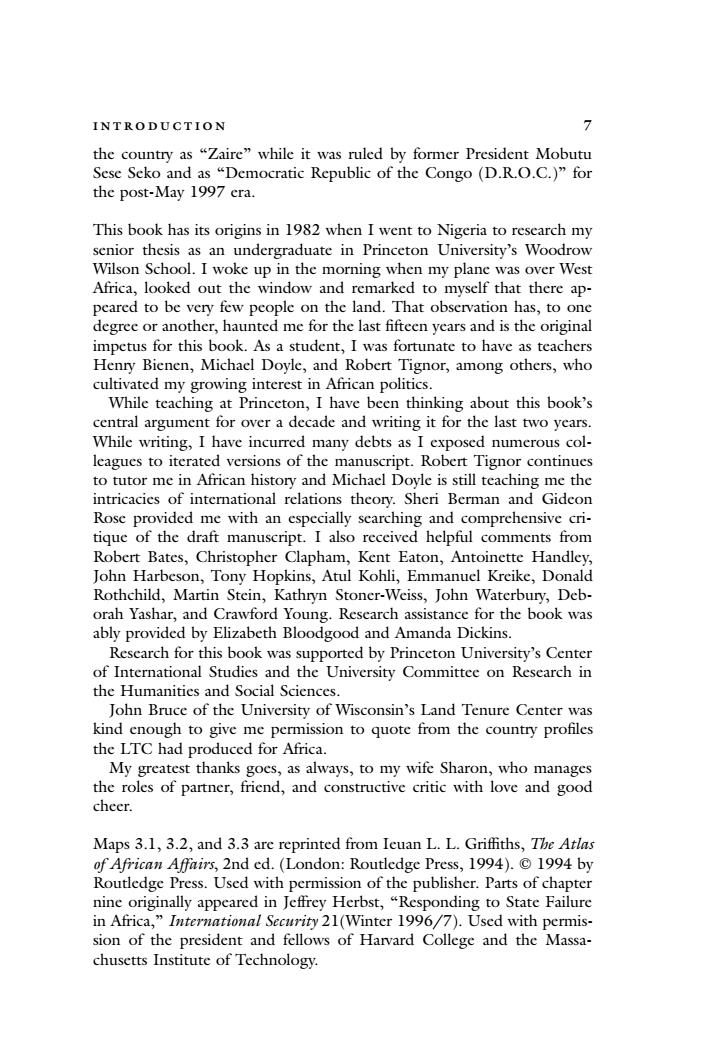正在加载图片...

INTRODUCTION 7 the country as "Zaire"while it was ruled by former President Mobutu Sese Seko and as "Democratic Republic of the Congo(D.R.O.C.)"for the post-May 1997 era. This book has its origins in 1982 when I went to Nigeria to research my senior thesis as an undergraduate in Princeton University's Woodrow Wilson School.I woke up in the morning when my plane was over West Africa,looked out the window and remarked to myself that there ap- peared to be very few people on the land.That observation has,to one degree or another,haunted me for the last fifteen years and is the original impetus for this book.As a student,I was fortunate to have as teachers Henry Bicnen,Michacl Doyle,and Robert Tignor,among others,who cultivated my growing interest in African politics. While teaching at Princeton,I have been thinking about this book's central argument for over a decade and writing it for the last two years. While writing,I have incurred many debts as I exposed numerous col- leagues to iterated versions of the manuscript.Robert Tignor continues to tutor me in African history and Michacl Doyle is still teaching me the intricacics of international relations theory.Sheri Berman and Gidcon Rose provided me with an especially searching and comprehensive cri- tique of the draft manuscript.I also received helpful comments from Robert Bates,Christopher Clapham,Kent Eaton,Antoinette Handley, John Harbeson,Tony Hopkins,Atul Kohli,Emmanucl Kreike,Donald Rothchild,Martin Stcin,Kathryn Stoner-Weiss,John Waterbury,Deb- orah Yashar,and Crawford Young.Research assistance for the book was ably provided by Elizabeth Bloodgood and Amanda Dickins. Research for this book was supported by Princeton University's Center of International Studies and the University Committee on Research in the Humanities and Social Sciences. John Bruce of the University of Wisconsin's Land Tenure Center was kind enough to give me permission to quote from the country profiles the LTC had produced for Africa. My greatest thanks goes,as always,to my wife Sharon,who manages the roles of partner,friend,and constructive critic with love and good cheer. Maps 3.1,3.2,and 3.3 are reprinted from Ieuan L.L.Griffiths,The Atlas of African Affairs,2nd ed.(London:Routledge Press,1994).1994 by Routledge Press.Used with permission of the publisher.Parts of chapter nine originally appeared in Jeffrey Herbst,"Responding to State Failure in Africa,"International Security 21(Winter 1996/7).Used with permis- sion of the president and fellows of Harvard College and the Massa- chusetts Institute of Technology.INTRODUCTION 7 the country as “Zaire” while it was ruled by former President Mobutu Sese Seko and as “Democratic Republic of the Congo (D.R.O.C.)” for the post-May 1997 era. This book has its origins in 1982 when I went to Nigeria to research my senior thesis as an undergraduate in Princeton University’s Woodrow Wilson School. I woke up in the morning when my plane was over West Africa, looked out the window and remarked to myself that there appeared to be very few people on the land. That observation has, to one degree or another, haunted me for the last fifteen years and is the original impetus for this book. As a student, I was fortunate to have as teachers Henry Bienen, Michael Doyle, and Robert Tignor, among others, who cultivated my growing interest in African politics. While teaching at Princeton, I have been thinking about this book’s central argument for over a decade and writing it for the last two years. While writing, I have incurred many debts as I exposed numerous colleagues to iterated versions of the manuscript. Robert Tignor continues to tutor me in African history and Michael Doyle is still teaching me the intricacies of international relations theory. Sheri Berman and Gideon Rose provided me with an especially searching and comprehensive critique of the draft manuscript. I also received helpful comments from Robert Bates, Christopher Clapham, Kent Eaton, Antoinette Handley, John Harbeson, Tony Hopkins, Atul Kohli, Emmanuel Kreike, Donald Rothchild, Martin Stein, Kathryn Stoner-Weiss, John Waterbury, Deborah Yashar, and Crawford Young. Research assistance for the book was ably provided by Elizabeth Bloodgood and Amanda Dickins. Research for this book was supported by Princeton University’s Center of International Studies and the University Committee on Research in the Humanities and Social Sciences. John Bruce of the University of Wisconsin’s Land Tenure Center was kind enough to give me permission to quote from the country profiles the LTC had produced for Africa. My greatest thanks goes, as always, to my wife Sharon, who manages the roles of partner, friend, and constructive critic with love and good cheer. Maps 3.1, 3.2, and 3.3 are reprinted from Ieuan L. L. Griffiths, The Atlas of African Affairs, 2nd ed. (London: Routledge Press, 1994). q 1994 by Routledge Press. Used with permission of the publisher. Parts of chapter nine originally appeared in Jeffrey Herbst, “Responding to State Failure in Africa,” International Security 21(Winter 1996/7). Used with permission of the president and fellows of Harvard College and the Massachusetts Institute of Technology